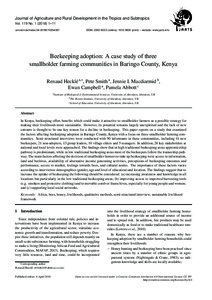| dc.date.accessioned | 2018-04-09T11:15:59Z | |
| dc.date.available | 2018-04-09T11:15:59Z | |
| dc.date.issued | 2018-04-04 | |
| dc.identifier.issn | 1612-9830 | |
| dc.identifier.issn | 2363-6033 | |
| dc.identifier.uri | urn:nbn:de:hebis:34-2018010254087 | |
| dc.identifier.uri | http://hdl.handle.net/123456789/2018010254087 | |
| dc.language.iso | eng | |
| dc.publisher | Kassel University Press | ger |
| dc.rights | Urheberrechtlich geschützt | |
| dc.rights.uri | https://rightsstatements.org/page/InC/1.0/ | |
| dc.subject | Africa | eng |
| dc.subject | bees | eng |
| dc.subject | honey | eng |
| dc.subject | livelihoods | eng |
| dc.subject | qualitative methods | eng |
| dc.subject | semi-structured interview | eng |
| dc.subject | sustainable livelihood framework | eng |
| dc.subject.ddc | 630 | |
| dc.title | Beekeeping adoption: A case study of three smallholder farming communities in Baringo County, Kenya | eng |
| dc.type | Aufsatz | |
| dcterms.abstract | In Kenya, beekeeping offers benefits which could make it attractive to smallholder farmers as a possible strategy for making their livelihoods more sustainable. However, its potential remains largely unexploited and the lack of new entrants is thought to be one key reason for a decline in beekeeping. This paper reports on a study that examined the factors affecting beekeeping adoption in Baringo County, Kenya with a focus on three smallholder farming communities. Semi-structured interviews were conducted with 90 informants in these communities, including 41 new beekeepers, 21 non-adopters, 13 group leaders, 10 village elders and 5 teenagers. In addition, 28 key stakeholders at national and local levels were approached. The findings show that in high traditional beekeeping areas apprenticeship pathway is predominant, while in low traditional beekeeping areas most of the beekeepers follow the traineeship pathway. The main factors affecting the decision of smallholder farmers to take up beekeeping were access to information, land and beehives, availability of alternative income generating activities, perceptions of beekeeping outcomes and performance, access to market, feelings towards bees, and cultural norms. The importance of these factors varies according to interviewee demographics (gender, age and level of education) and location. The findings suggest that to increase the uptake of beekeeping the following should be considered: (a) increasing awareness and knowledge in all locations but particularly in the low traditional beekeeping areas; (b) improving access to improved harvesting tools (e.g. smokers and protective clothing) and to movable comb or frame hives, especially for young people and women; and (c) supporting local social networks. | eng |
| dcterms.accessRights | open access | |
| dcterms.bibliographicCitation | In: Journal of Agriculture and Rural Development in the Tropics and Subtropics. Kassel : Kassel University Press. - Vol. 119, No. 1 (2018) S. 1-11 | |
| dcterms.creator | Hecklé, Renaud | |
| dcterms.creator | Smith, Pete | |
| dcterms.creator | Macdiarmid, Jennie I. | |
| dcterms.creator | Campbell, Ewan | |
| dcterms.creator | Abbott, Pamela | |
| dc.description.everything | Gedruckte Ausg. im Verlag Kassel Univ. Press (www.upress.uni-kassel.de) erschienen. | ger |

